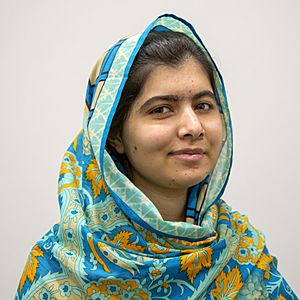Malala's Magic Pencil facts for kids

Front cover
|
|
| Author | Malala Yousafzai |
|---|---|
| Illustrator | Kerascoët (internal illustrations) Sarah J. Coleman (title lettering and illustration) |
| Language | English |
| Genre | Picture book, autobiography |
| Publisher | Little, Brown and Company |
|
Publication date
|
17 October 2017 |
| Media type | |
| Pages | 48 |
| ISBN | 9780316319577 |
| OCLC | 3999882421 |
Malala's Magic Pencil is a 2017 picture book authored by Malala Yousafzai and illustrated by Kerascoët. The book was published by Little, Brown and Company in the U.S., and Puffin Books in the U.K., with Farrin Jacobs as editor. It shows Yousafzai growing up in Swat, Pakistan, and wishing for a magic pencil to solve her problems; she learns that she is able to make change, such as advancing rights to female education, without one. The book has received very positive reviews, praising both Yousafzai's writing and Kerascoët's illustrations. The book appears on several lists of best children's books of 2017.
Background
Malala Yousafzai is a Pakistani female education activist. Born in Swat Valley in Pakistan on 12 July 1997, she was raised by parents Ziauddin Yousafzai and Tor Pekai Yousafzai alongside two younger brothers Khushal and Atal. At age 11, Malala Yousafzai began writing an anonymous blog for BBC Urdu, detailing her life in Pakistan under the growing influence of the Taliban. Following the blog, she was the subject of a New York Times documentary Class Dismissed, and spoke out for female education in local media. Yousafzai was revealed as the author of the blog in December 2009, and as her public profile rose, she began to receive death threats. On 9 October 2012, a member of the Taliban shot Yousafzai as she was taking a bus from school to her home. She was first sent to a hospital in Peshawar, and later to one in Birmingham. She continued to rise to fame and speak out for the rights of girls; at age 17, she became the youngest Nobel Prize laureate by winning the 2014 Nobel Peace Prize.
In 2013, Yousafzai co-wrote her memoir I Am Malala with Christina Lamb, which was on the New York Times bestseller list for two weeks; in 2014, a youth edition of the book was published. Yousafzai decided to write a picture book as "many young children are interested in my story" and she wanted them to "see that even one person's actions can create change"; In October 2016, it was reported that Yousafzai was writing a picture book to be released in autumn 2017. Malala's Magic Pencil was inspired by Shaka Laka Boom Boom, an Indian television series about a young boy who owns a magic pencil. In an interview, Yousafzai says that writing the book was an "intense" process, involving a lot of work looking up dates and fact checking. Yousafzai also had to assist in "choosing the artists, figuring out how to express everything in pictures, and deciding if the art felt accurate—down to the cracks in the wall of our home."
Malala's Magic Pencil was published on 17 October 2017 by Little, Brown and Company in the U.S., and Puffin Books in the U.K. French illustrators Marie Pommepuy and Sébastien Cosset, known together as Kerascoët, provided the artwork for the book, and Farrin Jacobs served as editor. The front cover, other than Kerascoët's illustration of Yousafzai as a child, was designed by Sarah J. Coleman, also known as Inkymole.
Synopsis
The book is written in the first person from the perspective of Malala Yousafzai, and documents her as a child, with a desire for a magic pencil to solve issues in her life; images depict her childhood home in Swat Valley. Using a simple vocabulary, it features watercolour illustrations, overlaid on which are "gold embellishments" and "bronze foiled swirls". The book is aimed at readers between ages 4 and 8.
The book begins with the line "Do you believe in magic?" Yousafzai tells the reader about a television show about a boy with a magic pencil. Yousafzai says that if she had one, she would use her magic pencil for minor things such as to "stop time" in order to get more sleep or to create a football for her brothers. As she grows older, Yousafzai begins to wish that she had a magic pencil for more serious issues, such as to bring about peace. Though she never gets a magic pencil, she learns that she can change the world without one; by writing speeches about the injustice of girls being deprived of education, she can make a difference. Alluding to her shooting by the Taliban, the text "My voice became so powerful that the dangerous men tried to silence me. They failed." appears on a completely black page.


